Did you ever think about rope and survival in the same sentence or scenario?
Well, if you didn’t, you should from now on because one of THE essential items in any respectable survival kit or bug out bag is a strong, solid piece of rope. What kind of rope should you use, though?
To tell you the truth folks, the old-school rope used by our ancestors to drag stones, tie up vindictive wives and hang total strangers is almost obsolete; paracord is the new kid on the block for good reason but we’ll get to that in a minute.
Now, if you were wondering about what type of rope you should buy, and why, for your BOB or your emergency survival kit (because there are lots of choices on the market, believe me), this article is about to enlighten you.
Let’s start with the most common types of outdoor/survival ropes commercially available and later in the article we’ll concentrate on the best choice. You’ve probably already guessed which we think is best but let’s play it by the book and give you your options so you can decide for yourself.
The twisted rope aka laid rope looks like a spiral and it’s usually made of three strands (polypropylene wire most of the time) twisted together, hence the name. This is not the strongest nor the best rope design out there but nevertheless, it has its uses – it’s impervious to water and it also sinks, unlike many others types of rope – and it’s dirt cheap.
Definitely not a good choice for a survival rope, though. It rots quickly and isn’t agile. Also, it’s bulky and the individual strands aren’t that useful alone. In this case, you get what you pay for but it’s better than nothing in a pinch.
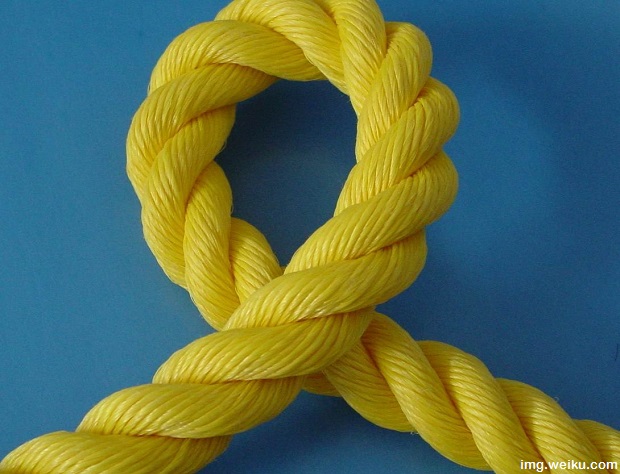
Braided ropes are built by weaving fiber strands and come in 2 types: hollow and double braided. This kind of rope is very popular in marine applications but for survival, we would stay away from this beast. Braided ropes rot quickly, they stretch and they don’t unbraid well. They are fairly strong when new, though.

Climbing ropes (the modern versions) feature a cool design, just like parachute cord, called the kernmantle design.
 This fancy word comes from the German kern which means core and mantel which translates into jacket.
This fancy word comes from the German kern which means core and mantel which translates into jacket.
Basically, you have an inner core made of separate strands (this means strength beyond strength) and an outer jacket that’s resistant to abrasion, making the rope durable and tear resistant.
This kind of rope stretches very little under stress and it’s capable of supporting heavy loads without breaking. It’s much bulkier than paracord though.
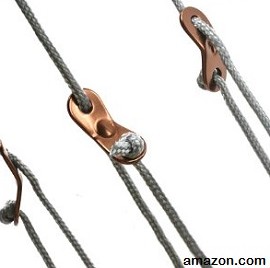 Guyline cords are pretty obviously not the droids you’re looking for, since they’re very different from regular survival ropes and they’re not able to do the job, not by a long shot.
Guyline cords are pretty obviously not the droids you’re looking for, since they’re very different from regular survival ropes and they’re not able to do the job, not by a long shot.
Even if they are pretty handy when it comes to replacing or lengthening a tent/tarp guyline, we don’t recommend them because they’re not much good for anything else.
Bungee cord is also known as a shock cord and it’s an elastic type of “rope” which consists of one or more elastic strands (the core) and an outer sheath made of propylene or woven cotton.
Bungee cords are extremely handy if you’re trying to lash things together so if you have room, it isn’t a bad item to toss in. It’s not a good choice for use as your primary rope, though. They’re too stretchy, you can’t really unravel them to use the separate cords, and they rot fairly quickly in the elements. Also, they’re usually extremely short – only 3 feet long at most.

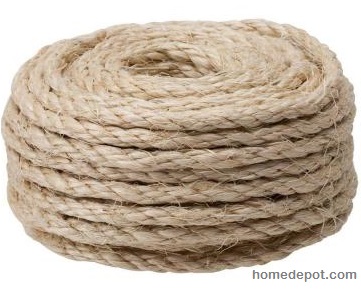 Sisal is a natural fiber and it’s basically a plant (Agave sisalana, hence the name), which is very popular for its stiff fibers that are used for making rope, cordage, rugs and similar items.
Sisal is a natural fiber and it’s basically a plant (Agave sisalana, hence the name), which is very popular for its stiff fibers that are used for making rope, cordage, rugs and similar items.
There are people who actually use sisal rope for all sorts of things because it costs next to nothing and it copes well with salt water. Not my first choice for a survival rope because it’s coarse and relatively bulky.
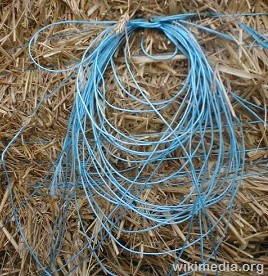 Baling twine is a thinner type of the previous sisal rope, as it comes in a smaller diameter and it’s widely used for tying up hay bales and what not (it has ~350 pounds of
Baling twine is a thinner type of the previous sisal rope, as it comes in a smaller diameter and it’s widely used for tying up hay bales and what not (it has ~350 pounds of
breaking strength and that’s not bad at all for such a cheap rope).
Even if it’s fairly cheap and strong, this is definitely not a valid choice when it comes to survival. It’s not particularly agile, i has a fairly limited usage, you can’t use the fibers separately and it’s bulky.
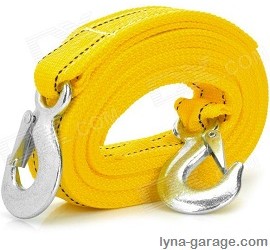 A tow strap is not actually a rope but it works as one, being used for towing cars, boats and stuff like that.
A tow strap is not actually a rope but it works as one, being used for towing cars, boats and stuff like that.
Even if it’s “born hard”, this is not actually survival rope per se, but you should have one in your car at all times regardless because if you’re stuck, it’s absolutely the best at it it’s intended purpose: towing.
The Paracord
Last but not least (actually my first choice when it comes to survival ropes) is the rock-star of the bunch, the parachute cord, also known as paracord.
Paracord, along with duct tape, equates to the difference between meat eaters and vegetarians in the modern survival world – it’s all-inclusive. Because I’m a perfectionist who likes the best of the best when it comes to gear (affordable gear that is, I’m not a billionaire), I strongly suggest paracord as THE survival rope you should have in your prepping paraphernalia.
Paracord is basically a fancy name for parachute cord (because that’s what paracord really is, an acronym). It’s the latest and the greatest in rope technology, and I’m being very serious about this issue.
For the moment, let’s forget about technicalities and call it simply survival rope. The survival part derives from the rope’s main role, i.e. one versatile piece of gear that comes handy in hundreds of survival situations. Actually, you can use this rope in so many scenarios that it’s an exercise in futility trying to memorize or enumerate all the potential situations in which you’d require such a thing.
The 550 Paracord is the rope that the military has been using since World War 2. It has since it proved itself in battle and in emergency situations many times over. It became largely used by both military and civilians in the 21st century.
Paracord is made of lightweight nylon using the kernmantle technology (as I described it before, a strong inner core and a tear resistant sheath – a cool German design that offers high strength, resilience and flexibility) and 550 comes from its official rated strength.
{adinserter emp}Now, if you want the best of the best and not cheap “Made in China” knock-offs, you should choose MIL-C-5040 Type III paracord; that’s the real deal. You’ll find cheaper 550 paracord out there, marketed alongside the mil-spec or military grade but stay away from these because they’re cheap knock-offs and they’ll fail you when SHTF.
Authentic 550 paracord has a core built of 7-9 strands intertwined in pairs of two (sometimes three) which makes for fourteen (or 21/27) strands in total. The outer sheet (or the mantle) is built of braided nylon. I must emphasize this again: the 550 paracord is really great and you’ll thank me if you ever have to use it in a real survival situation.
One of paracord’s main attributes besides its awesome strength is that it weighs next to nothing and that’s huge factor when you have to carry lots of gear with you. Also, it dries quickly and doesn’t rot/mildew when wet. You can buy high quality paracord for as little as $12.99/100’, which is enough for regular use. It’s made in USA and is available on Amazon and various other online retailers.
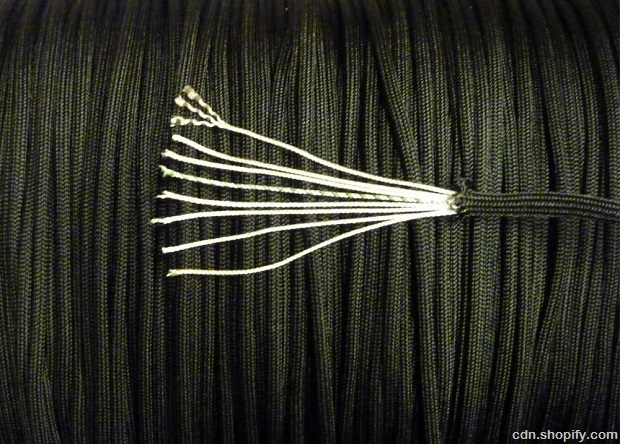
Survival rope has so many uses that you can write a book just by enumerating them alphabetically; actually it all comes down to one’s creativity and imagination.
But the essential uses for paracord as a survival rope can be (briefly) summarized as follows:
- Fishing
- Building traps/snares
- Boot laces
- Flossing
- Climbing/hiking
- Sewing thread
- Building shelter
- Tying down a tarp
- Holding gear together
- Securing items on top of your car
- Repairing torn/broken equipment
- Making a tourniquet
- Tying things to your backpack
- Trip wires
- Rigging a pulley system for lifting heavy gear
- Building a ladder
- Improvising a hammock
- Building a raft
- Making a sling/catapult
- As a bow drill for starting a fire
- Building a stretcher (run paracord between two solid sticks)
- Sewing up an open wound (using the internal core/strands)
As you can see, the uses are practically endless for paracord. You can use the rope whole or you can un-twine them to use each strand separately depending upon your needs. This is a vital piece of gear that should be included in all BOBs and packs, even in the kids’.
CLICK HERE to find out more about packing your BOB to survive in the wild.
This article has been written by Chris Black for Survivopedia.





































































braided 4mm cord non paracord is hard to find .. good for boot lace … good for zipper pulls ..paracord is too slippery and knots can slide out ..braided cord is not as strong as 4mm paracord [ 550#] but the uses for which it is needed do not require the extreme strength of paracord.. paracord ends must be burned or the sheath will slide
Hey Chris,
I just started reading the rope article n I see you said the polypropylene rope sinks, if I’m not mistaken it should say that it floats.
Jim
Tarred bank line is some excellent multi-use cordage.
Paracord is great for a great many things, however, since we often think of using rope for climbing (or lowering, ourselves or something else), paracord leaves something to be desired. I have run into situation where I needed to lower myself, often only 10-12 feet, but was glad I had something big enough to hang onto. rather than something so small it would be very hard to do so. I carry about 20 ft of a rope, not sure what it’s called, kind of between braided and climbing rope, and, since it is so small about 50 ft of paracord.
Don’t forget zip ties of various lengths both plastic and metal. These can be used for a variety of purposes from repair to temporary shelter lashings.
The best rope is what is east to splice, carry, and can be used for most any use that humans can come up with. My personal favorite is what is used for sailing. The 3/8 inch rope sells for roughly 50cents/ft, however, it has the tensile strength 4,250 lbs. For the cost it is well worth the money. It cuts easily, it can be spliced easily, and knots do not slip. Just think of what could be done with a smaller diameter such as 1/4″ or 5/16″. It is sold at all Marine Supply houses.
Polypropylene’s ability to float on water is, however, its most valuable attribute for the sailor. Used in applications from rescue lines to dinghy tow ropes it remains on the surface resolutely refusing to get dragged into propellers or lost under boats.
There is a twine made from recycled pop bottles. It appears to be stronger than all-get-out. It is really inexpensive but care needs to be taken to not use it without gloves. Minute triangular pieces of plastic will come off and imbed themselves into your hands. Strong, cheap, comes in grey spools like bailing twine. It has many good uses – please, use gloves.
I found paracord to work for a wide range of things. I always buy more than what i want to put in my BOB. I always have paracord on hand for whatever the task at hand may be. I even have a paracord necklace so that way i always have a bit of it with me at all times.
I have about all of the types of rope shown. I have a paracord anklet and bracelet, too. I’m a “good stuff” junkie. I can’t tell you how many knives and flashlights I have. They aren’t all in the same place. I can grab one anywhere.
Chris your bio fits me pretty well and think I have some idea where you are coming from. Growing up in the logging business 70 years ago and a long-haul trucker for a while before following other more adventurous pursuits the use of Paracord would probably have got me killed or limbs cut off. I know and can tie just about every knot there us and agree with most of the comments especially Willowa and Johnny P . I have used miles of Sisal and when fresh it is the best for securing bulky loads. I also have hundreds of feet of Paracord and it is included in all my survival equipment for the reasons you stated but if it gets away from you it will hurt you badly or kill you.
So climbing rope stretches “very little under stress” does it?
There was me thinking that the dynamic nature of climbing rope meant it’s designed to stretch by a significant amount (6% of its total length, more for half and twin ropes by themselves)
Just ask any climber who’s ever needed a rest if climbing rope stretches or not.
Don’t even get me started on making people think it’s ok to go climbing with a rope that has “very little stretch” because you want to nurse broken ribs or a slipped vertebrae after a short jolt during a survival situation of course.
When there’s such a massive piece of misinformation I find it difficult to trust anything else in the article or find much credibility from the author.
Maybe I’m being too harsh?
Maybe I clicked on a survival article about rope and y’know, expected the author to know something about rope…
@Chris…
The “vindictive wives” part of your
article made me laugh!
BIND CRAFT is one of the many…
…VITAL SKILLS…NEEDED…
…concerning BUSH CRAFT
also known as Wood Lore and Wood Craft.
These are some other Bushcraft Skills to Learn, Practice and Master:
~Knife Craft
~Axe Craft
~Fire Craft
~Bind Craft
~Camp Craft
~Trail Craft
~Water Craft
~Plant Craft
~Animal Craft
Cordage is important.
i would add to Para cord and Duct Tape and para cords:
~(Red Tuct tape is very good and very sticky also, but not good in the cold, whereas Duct tape is fine in even -50 C + Temps…).
~heavy gauge Fish line.
~heavy and light weight wire.
~high quality light rope.
(stronger than Para cord, but not the heavy duty quality to climb mountains, and do repelling.
~climbers rope; 20′, 50′, and 100′.
~ Ratchet straps and towing ropes also have their place, and steel hauling cable, with end of cable “eye’s” for hooking on.
~Also:
“A cable tie or tie-wrap, also known as a hose tie, zap-strap, or zip tie,[1] is a type of fastener, for holding items together”.
http://en.m.wikipedia.org/wiki/Cable_tie
~i find much value in Quality:
key rings, belt hooks, carabiners etc.
( things that hold things together).
~recommend learning at least 12 basic knots, the ones i have used the most in my life are the Bowline, and the reef knot, and hitches.
As for the Bowline…
( once you figure it out and master it, you can then not only use it for small stuff… but use it to secure a warship
to the jetty)…
Check out the Ashley book of knots:
http://en.m.wikipedia.org/wiki/The_Ashley_Book_of_Knots
~Rope can be made from garbage bags, bed sheets and other means.
( look into the poor mans way(s) to
to acquire and make cordage!
~The last and final stand, and Skill concerning Cordage is:
HOW TO make cordage from Nature.
Research it, practice it.
_________________________________
Si Vis Pacem Parabellum
_________________________________
“Improvise, Adapt, Overcome, Survive”.
Author Unknown
_________________________________
“The axe is the most important bush tool there is. Outside of fire, nothing may contribute to your comfort and leisure than a well chosen axe.”
Mors Kochanski
_________________________________
“Be Prepared”
Boy Scout Motto
_________________________________
Most important concerning Survival;
is Put Your Trust in Our Lord and Saviour Jesus Christ!
_________________________________
Good Article Chris, Thanks,
may it help many people.
Brear
P.S.
This may sound wierd concerning “Cordage”,
… but…
a roll of plastic wrap also will hold a leak well… and can be used to secure thingy’s…
🙂
Two and only the only two cordage you need
Mil spec Para cord
Mule Tape
That is all you need, PERIOD
I had no idea there were so many different types of ropes! Thanks, for pointing out that tow ropes are built for towing and that you should use those instead of regular rope. I’ll have to make sure that instead of using normal ropes to tow I buy some tow straps.